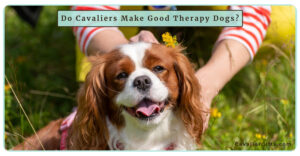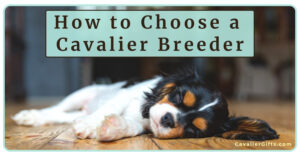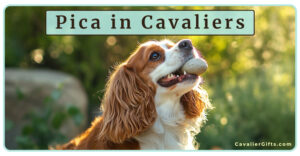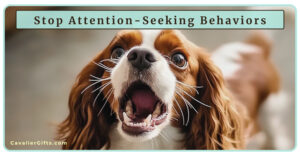Cavalier King Charles Spaniel Potty Training


Congratulations on welcoming a Cavalier King Charles Spaniel into your life! They’re such charming and affectionate dogs, full of warmth and love. As a fellow Cavalier mom and positive dog trainer, I’m thrilled to share my experience on the best way to potty train a Cavalier puppy. Let’s jump right in to how to successfully housebreak your Cavalier King Charles Spaniel puppy.
I love puppies! And Cavalier puppies are just some of the cutest little things ever! There’s nothing quite like their sweet kisses, puppy breath, and zest for life! But it’s not all puppy kisses; we also must potty train our Cavaliers. Nobody likes an untrained dog.
One common question I get from Cavalier followers is how to best potty train their puppy. I’ve seen plenty of discussions about potty accidents in Cavalier King Charles Spaniel groups, and I’m here to share some potty training tips with you.
First things first. Let’s start by being realistic. Contrary to what some may suggest, potty training a puppy in a matter of days is not realistic. It’s important to realize that puppies, just like human babies, need time to learn and gain control over their bladders. So, if you’re expecting your Cavalier to hold it for hours after just a few days of training, you are setting your pup and yourself up for failure.
My own Cavalier, Dexter, wasn’t fully potty trained in a mere five days, and I’m perfectly okay with that. I prioritized consistent management and frequent potty breaks, which ultimately led to just a couple of accidents in the house. The key is to prevent accidents by being proactive, not reactive.

What’s the best way to potty train your Cavalier puppy?
It all comes down to three essential things: supervision, frequent potty breaks, and confinement when you can’t actively watch them. The goal is to reduce the chances of accidents happening indoors.
When it comes to supervision, it’s eyeballs on! This means keeping a watchful eye on your puppy at all times, ensuring that you’re there to rush them outside if it looks like they are about ready to go. You can use things like baby gates, leashes, shut doors, or X-pens so that you can keep your eyes on them at all times.
Don’t forget to subscribe to @RaisingYourPetsNaturally for more!
How Often Should You Take Your Puppy Potty?
As for how often to take your puppy potty, it really depends on their age and activity level. Active puppies may need to go out every 15–30 minutes, while older dogs can typically hold it for longer periods. The key is to stay ahead of the game and take your puppy out whenever you notice a change in their behavior or activity. A change in behavior or activity signals that it’s time for a bathroom break. For example, if your puppy just had a bout of puppy zoomies, out to potty we go. Did your puppy wake up from a nap? Out to potty we go. By not waiting for your puppy to ask to go out or have an accident, you are well on your way to a potty-trained dog.
When it comes to crate training, make sure the crate is just the right size to discourage accidents. The crate should be large enough for your pup to stand and lie down comfortably, but not so large that they can use one corner as a bathroom.
Whether you have a fenced yard or not, leash your puppy. This gives you the opportunity to reward your puppy for going potty outside. You will be right there to praise your puppy, give him a snack, and tell him just how smart he is. It also leads to my next potty training tip: teaching your Cavalier to potty on cue!
Teaching your Cavalier to potty on cue is a must in my book. Imagine being able to take your dog outside just before the rainstorm and ask him to pee and poo, and he does! This useful behavior isn’t just fantastic for potty training your dog; it’s incredibly convenient in daily life. The keys to teaching your Cavalier to eliminate on cue are good management, timing, and your reward. By associating a word for peeing with a separate word for defecating, you can start to teach your puppy to do either when requested.

Subscribe to @CavalierTipsandFun
Teaching Your Cavalier to Potty on Cue
Here’s how to get started:
Begin the training process in the morning, when your pup wakes up. Arm yourself with some delicious treats, leash up your Cavalier, and head outside to his favorite potty spot.
Stay close and pay attention to your puppy. Stay about 6’, so it’s not just a sniffing fest; the goal is to get him to eliminate before a big walk, play, or sniff. Pay close attention to your Cavalier’s body language. Watch for subtle cues like sniffing, circling, or squatting, which indicate he’s about to eliminate. As soon as you see a sign, use your potty cue, such as “Go potty,” and wait patiently. When your pup starts to do his business, praise quietly, and after he’s finished, give him big praise and rewards. You want to make sure you don’t interrupt the potty process by rewarding too soon.
If your dog typically follows up with a poop, repeat the process with your poop cue, like “Go poop-poop,” and reward him once he’s finished.
After your Cavalier has finished his business, it’s time for the next reward: fun! Whether it’s a walk, playtime in the yard, or simply enjoying the fresh air, make sure to give your pup some extra time to enjoy himself before heading back indoors. This helps reinforce the idea that going potty leads to enjoyable activities.
Repeat this routine each time you take your Cavalier outside, even if you’re planning on going for a walk. By always pairing potty time with rewards, you’ll motivate your pup to go more quickly.
As your Cavalier starts to make the connection between potty on cue and familiar surroundings, gradually introduce the cue in different environments, such as the park or during walks. This helps your dog understand the cue in any situation, ensuring they respond reliably wherever you are.
With patience, consistency, and plenty of positive reinforcement, you can teach your Cavalier King Charles Spaniel to potty on cue, making potty training easier.
Subscribe to @CavalierTipsandFun on YouTube!
Bell Training Your Cavalier King Charles Spaniel Puppy
While some love doggie doorbell training or puppy pads, I prefer to focus on methods that teach puppies to potty outside, not inside or on “things.” I find these methods tend to confuse puppies. Potty pads or litter boxes are teaching the puppy to potty on things that happen to be indoors. This could be a potty pad, but it also could end up being your favorite blanket.
As far as bell training goes, I’m not a fan of encouraging demanding behavior in dogs. Teaching them to ring bells to go outside may inadvertently lead to them using this to not only tell us they need to potty, but also that they may want to go outside to chase squirrels.
I believe in keeping potty training simple and straightforward, focusing on reinforcing the desired behavior of outdoor elimination. By keeping things simple and staying consistent, we can focus on potty training without having to rely on pee pads or bells.
In the end, potty training your Cavalier King Charles Spaniel is all about patience, consistency, and a whole lot of love. By following these tips and staying diligent, you’ll set your new puppy up for success.
Your comments and questions are always welcome below.
Join our vibrant Cavalier King Charles Spaniel community on Facebook, support our dedication to pet wellness on Patreon, and stay updated with our weekly newsletter for invaluable tips and insights into raising happy, healthy pets. Together, let’s make a difference in our dogs’ lives!

|
|

|

|
Google Ad Below

























Annie who is about 18 months has finally started to urinate outside. The only problem is that she doesn’t understand she needs to poop outside also. There are two places she prefers to poop in the house. A corner in the family room and a corner in the bedroom. She will go outside and potty but come back in and poop in her favorite places. She is a very smart pup but she doesn’t seem to understand pooping in the house. One thing may be that she will eat her poop with the help of her sister, Bella, soon to be 2. Any help will be truly appreciated. Hannah on the other hand did everything possible to poop and potty outside. These girls also like to eat mulch which is a big distraction. I did away with all flower beds in the backyard but their is still small pieces that they can get out of the grass. I hope all of this makes sense.
Great job with Annie! I would spend more time outside with her to poop. Follow the teaching your pup to potty on cue, so eventually you can get the poop on cue too. If she hasn’t pooped and you feel she needs to, eye balls must be on. Going to the bathroom in the house doesn’t help in training. So, tether, crate, in room with you. Then, when she looks like she’s ready, outside you both go. If you are with them when outside, then you can actually scoop after they go, which is pretty important if you have poop eaters. The same with the mulch. I’m not a fan of unsupervised yard time, for these very reasons. Dogs easily pick up bad habits, and can actually hurt themselves. I knew a dog who at mulch and had major surgery….twice! Just luckily the dog survived, which unfortunately isn’t always the case. Teaching them good habits now, can help with less supervising in the future. Although, honestly, I’m still I’m with you outside kind of gal. Especially with small dogs like Cavaliers, birds of prey, coyotes and even snakes can be a huge concern. If you stay in the yard, you can put short little fence structures around your non-poisonous flowers, which can help deter them, with a verbal recall when they get too close. Good luck! Keep me posted. ~Tonya
Thank you!!!
Where do you get your snoods?
Various small business on Etsy. My go to is MeekByDesign. https://www.etsy.com/shop/MeekByDesign
Thank you!!!